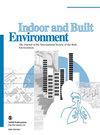使用无香味卡尔曼滤波器和非线性最小二乘法对建筑物的 RC 热模型进行参数-输入估计
IF 2.9
3区 工程技术
Q2 CONSTRUCTION & BUILDING TECHNOLOGY
引用次数: 0
摘要
有效的建筑能源管理(如温度控制策略)需要可靠且计算效率高的建筑热模型。电阻电容(RC)模型就是其中的一种。然而,同时估算模型参数和输入(如太阳辐射热获得)是一项挑战,尤其是当由于仪器限制和/或传感器故障而导致某些温度状态缺失时。本研究利用无特征卡尔曼滤波器(UKF)和非线性最小二乘法(NLSs)对可能存在温度状态缺失的 RC 模型进行参数和输入估算。详细介绍了估算过程、数学运算和结果分析。为了评估该方法的能力,进行了两个案例研究。第一个案例研究涉及一个简单的、具有已知参数、输入和状态的 RC 模型,而第二个案例研究则使用了一个独立房屋的监测数据。通过比较两个研究案例中的估计参数、输入和状态与相应的真实值,对该方法的能力进行了评估。性能评估结果表明,即使在某些状态缺失的情况下,所提出的方法也能有效地估算 RC 模型参数和输入。建议的方法可用于及时在线更新 RC 模型参数,以改进响应预测。本文章由计算机程序翻译,如有差异,请以英文原文为准。
Parameter-input estimation of RC thermal models of buildings using unscented Kalman filter and nonlinear least square method
Effective building energy management (e.g. temperature control strategies) necessitates reliable and computationally efficient building thermal models. One type of them is the resistor–capacitor (RC) model. However, estimating model parameters and inputs (e.g. solar heat gain) simultaneously is challenging, especially when some of the temperature states are missing due to instrumentation limitations and/or sensor malfunctions. The present study utilizes unscented Kalman filter (UKF) and nonlinear least squares (NLSs) methods for parameters and input estimation of RC models with possible unavailable temperature states. The estimation procedure, mathematical operations and result analysis are presented in detail. To evaluate the capability of the method, two case studies were conducted. The first case study involved a simple, made-up RC model with known parameters, inputs and states, while the second case study used monitored data from a single detached house. The capability of the method was evaluated by comparing the estimated parameters, inputs and states to the corresponding true values in both study cases. The performance evaluation shows that the proposed method can effectively estimate RC model parameters and inputs, even with certain missing states. The proposed method can be employed for timely online updating of RC model parameters to improve response prediction.
求助全文
通过发布文献求助,成功后即可免费获取论文全文。
去求助
来源期刊

Indoor and Built Environment
环境科学-工程:环境
CiteScore
6.40
自引率
25.00%
发文量
130
审稿时长
2.6 months
期刊介绍:
Indoor and Built Environment publishes reports on any topic pertaining to the quality of the indoor and built environment, and how these might effect the health, performance, efficiency and comfort of persons living or working there. Topics range from urban infrastructure, design of buildings, and materials used to laboratory studies including building airflow simulations and health effects. This journal is a member of the Committee on Publication Ethics (COPE).
 求助内容:
求助内容: 应助结果提醒方式:
应助结果提醒方式:


